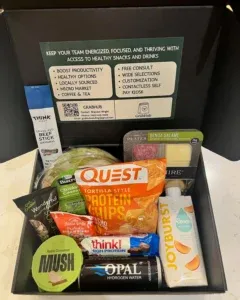Pricing • Phoenix, AZ
Micro Market Pricing Models in Phoenix: No-Cost, No-Contract, Fully Managed — What’s the Catch? (2025 Guide)
Short answer: there isn’t one. This guide explains how the business model works, what employers actually pay (or don’t), and how to choose the right plan for Facilities, HR, and Finance stakeholders.
Heads up: This article is for informational purposes only and is not tax advice. Always consult your tax professional.
Why Pricing Clarity Matters in 2025
Micro markets are unattended retail spaces—open shelves, coolers, and a self-checkout kiosk with cashless payment. They offer far more variety than a single vending machine and can meaningfully improve the breakroom experience for on-site teams.NAMA
Two trends make pricing transparency critical now: (1) continued adoption of cashless, unattended experiences and (2) renewed focus on employee amenities to support retention and in-office collaboration. Industry analyses show micro markets often produce significantly higher volume per location than traditional vending because of product breadth and higher average tickets.Fiserv/CaratWilliam Blair 2025
How Micro Market Pricing Works (Plain English)
In a no-cost, fully managed model, your operator funds equipment, installation, software, card processing, and ongoing service. Revenue comes from employee purchases at the kiosk—not from your facilities budget. Employers can optionally add:
- Subsidized pricing (e.g., 10–50% off at checkout) to support wellness or recruiting goals.
- Stipends/allowances (monthly balances per employee) for shift teams or late-night coverage.
- Revenue share/floor at high-volume sites, aligning incentives when traffic is predictable.
Tax classification for occasional office snacks is often treated as a de minimis fringe benefit when conditions are met; confirm specifics with your CPA.IRS Pub 15‑BIRS De Minimis
| Model | Typical Employer Cost | Best For | How It Works | Pros | Considerations |
|---|---|---|---|---|---|
| No-Cost, Fully Managed | $0 (equipment, install, service) | 75–100+ on-site employees; offices, warehouses, logistics hubs | Operator funds equipment & replenishment; revenue is generated at the kiosk. | Fast launch; no CapEx; minimal facilities lift; 24/7 access; cashless. | Assortment sized to demand; requires consistent traffic for sustainability. |
| Subsidized Pricing | Employer subsidy (e.g., 10–50% off shelf) | Wellness, RTO support, recruiting/retention moments | Kiosk applies an employer discount in real time at checkout. | High perceived value; boosts usage; can target “healthy” items only. | Budget tracking; align with HR/Finance policy and tax guidance. |
| Stipend / Allowance | Per-employee monthly credit | Shift work; late nights; peak seasons | Employer funds stored value for eligible users; balances can expire per policy. | Granular control; easy to tie to programs; great for night shifts. | Requires guardrails (eligibility, rollover, misuse handling). |
| Revenue Share / Floor | $0; optional share to location | High-traffic sites with predictable volume | Operator pays a small % of sales or a fixed floor back to the site. | Aligned incentives; encourages co-promotion. | Only fits certain volumes; may reduce operator margin. |
No-Cost, Fully Managed
Subsidized Pricing
Stipend / Allowance
Revenue Share / Floor
Eligibility & Headcount: What Size Workplace Fits?
There isn’t a single industry standard, but most operators look for steady daily traffic. Public benchmarks range from ~50 employees for compact formats to 100–200+ for full markets. What matters most is predictable footfall and purchase frequency.
- Compact markets can work around the 50–75 employee range.Allans Vending
- Many providers cite 75–100 as a strong fit for no‑cost installs.Bernick’sAvanti Markets
- Some guidance suggests 150–200+ when aiming for larger assortments and very robust results.Cantaloupe Guide
- For government sites, rule‑of‑thumb references cite ~100 daily customers and a “sweet spot” around 300 employees (context‑dependent).NCSAB
Bottom line: if you’re near 75+ on‑site employees (or equivalent daily traffic), you likely qualify for a no‑cost, fully managed market. We’ll validate the fit during a quick site survey.
Which Model Should You Choose?
Facilities & IT
- No-Cost for fast rollout and minimal lift (power for coolers + reliable network or cellular).
- Revenue Share if traffic is predictably high and you want an incentive-aligned partnership.
HR & People Teams
- Subsidies to promote healthy choices or RTO milestones (e.g., “20% off fresh items in Q4”).
- Stipends for night shifts or peak operations to support safety, hydration, and morale.
Finance
- Zero CapEx, OpEx only if you add subsidies or stipends.
- Reference IRS guidance for fringe benefits classification and documentation.IRS Pub 15‑B
Who Pays for What?
In a fully managed no-cost model, the operator funds equipment & service; employees pay at the kiosk.
Sources: industry descriptions & trend analyses.
NAMA •
Fiserv/Carat •
William Blair 2025
Rollout at a Glance (Phoenix Metro)
We cover Phoenix, Tempe, Mesa, Chandler, and Scottsdale—start to “grand opening” in ~30 days for standard installs.
-
Step 1
Discovery & Fit
We review on‑site headcount, hours, space, power, and network. A quick tour is enough for an accurate plan.
-
Step 2
Plan Selection
No‑cost baseline, then optionally add a subsidy, stipend, or revenue share as policy requires.
-
Step 3
Install & Go‑Live
We handle equipment, PCI‑compliant payments, inventory, and restocking. Facilities lift stays minimal.
-
Step 4
Optimize
Monthly assortment tuning and seasonal campaigns (e.g., hydration in summer; healthy‑eating months).
Security, Compliance & Shrink
Modern micro markets use multi‑layer protection—camera coverage, smart inventory, and kiosk controls—to keep shrink low while preserving the frictionless experience. For regulated environments and government sites, definitions and access controls are clearly scoped (e.g., “closed locations,” authorized access only).NAMA Tech BulletinWI ATCP 75.01
A Partnership Built on Trust
- Local Expertise: We operate, stock, and service micro markets right here in Phoenix. Our team uses PCI-compliant payment platforms and follows industry best practices to ensure smooth, reliable operations.
- Proven Experience: We have a track record of successful installations in diverse environments, from corporate offices to manufacturing plants, tailoring our services for needs like 24/7 access and seasonal assortments.
- Transparent & Flexible: We believe in earning your business every month. That’s why we offer a no-contract, month-to-month partnership with clear pricing and straightforward reporting.
- Informed Guidance: This guide is an example of our commitment to transparency. Our recommendations are backed by data and insights from authoritative sources like NAMA, ensuring you have the best information.
Pricing Model Questions We Hear Most
Our revenue comes from product sales at the kiosk. We fund equipment, installation, maintenance, and service.
We manage payment processing end‑to‑end, including transaction fees—your company is not billed for them.
For a full micro market, we typically recommend 75+ on‑site employees. For smaller sites, we propose a scaled format.
Decision Checklist
- Confirm daily on‑site traffic (target: 75+ for full market) and 24/7 access needs.
- Choose the pricing model: No‑Cost baseline, optionally layer Subsidy, Stipend, or Revenue Share.
- Decide on wellness or shift‑support policies (subsidies, stipends) and reporting cadence.
- Schedule a site survey for space, power, and network validation.






